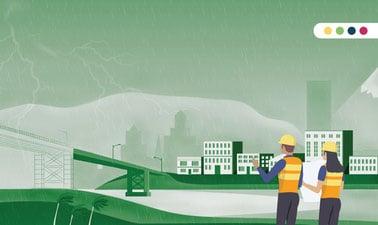MOOC List is learner-supported. When you buy through links on our site, we may earn an affiliate commission.

MOOC List is learner-supported. When you buy through links on our site, we may earn an affiliate commission.
Climate change is real, and it affects many aspects of our lives. Temperatures are becoming progressively more extreme and natural disasters are increasingly frequent. We cannot prevent floods, earthquakes, and tornadoes...
But what can we do so that the damage caused has the least impact? How can we prevent our city’s infrastructure from suffering any damage and therefore put fewer people at risk? What kind of pre-project analyses do we need to perform so that we are prepared to address future climate change events?
Strengthen your technical and decision-making skills by incorporating climate change resilience and natural disaster risk analysis into the design of infrastructure projects.
This course was designed and organized by the Inter-American Institute for Economic and Social Development (INDES) of the Inter-American Development Bank within the framework of its Operations Learning Program (OLP). Its objective is to strengthen project teams’ capacity to preemptively manage events that may affect a project so as to improve its chance of success.
What you'll learn
The general objective of the course is to strengthen the technical capacity of professionals involved in the project cycle for decision-making in relation to the incorporation of disaster risk assessment and resilience to climate change in the design of infrastructure projects.
By the end of this course, you will be able to:
- Identify the main elements of natural disaster risk.
- Recognize the importance of incorporating natural disaster risk assessment (including climate change effects) into the infrastructure project cycle.
- Carry out qualitative disaster-risk analyses to guide decision-making in infrastructure projects.
- Interpret quantitative disaster-risk analyses to guide decision-making in infrastructure projects.
- Identify when applying qualitative analyses is enough and when quantitative analyses should also be carried out to perform risk assessment in infrastructure projects.
- Identify technical and economic feasibility of infrastructure projects through a qualitative or quantitative analysis.
- Make risk-informed recommendations for the design, construction, and operation of infrastructures and develop disaster-risk-governance strategies.
Syllabus
Module 1 - Conceptual Framework of Disaster Risk Management
Acknowledge the concept of disaster risk governance and climate change adaptation and recognize the importance of incorporating climate change and disaster risk assessment into infrastructure projects. The purpose is to improve understanding of dimensions of hazard, exposure, and vulnerability and its role in infrastructure projects.
Module 2: Qualitative Risk Analysis
Identify the key aspects of a qualitative disaster risk analysis to prioritize the risks that can affect an infrastructure project.
Assess when applying qualitative analyses is enough and when quantitative analyses should also be carried out to perform risk assessment in infrastructure projects.
Module 3: Quantitative Risk Analysis
Discover the key concepts related to quantitative risk analysis with the purpose of determining and measuring the impact and probability of the main risks that can affect infrastructure projects. Additionally, tools for the representation of risk are presented (F-N and F-D curves), that support decision making.
Module 4: Making Decisions Incorporating Disaster-Risk and Economic- Feasibility Analyses in Infrastructure Projects
Identify technical and economic feasibility concepts of infrastructure projects, to analyze investment alternatives.
Different quantitative indicators are shown to support decision making in the definition of sequences of investments. Additionally, the principles of efficiency and equity are developed.
Module 5: Disaster Risk Governance, Including Climate Change Adaptation
Learn the main components of risk governance. The methodological framework for the case study of IDB’s investment projects is developed for the incorporation of risk analysis in the cycle of infrastructure projects; and key aspects and principles for preparing terms of reference to perform quantitative disaster risk analyses are described.
MOOC List is learner-supported. When you buy through links on our site, we may earn an affiliate commission.
MOOC List is learner-supported. When you buy through links on our site, we may earn an affiliate commission.
